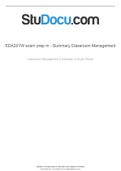lOMoARcPSD|3133703
EDA201W exam prep m - Summary Classroom Management
Classroom Management (University of South Africa)
StuDocu is not sponsored or endorsed by any college or university
Downloaded by Lina Slabbert (lina.slabbert@gmail.com)
, lOMoARcPSD|3133703
EDA201W – CLASSROOM MANAGEMENT
EXAM PREP
PART A – EFFECTIVE CLASSROOM MANAGEMENT.
CHAPTER 1: THE MILLENNIAL GENERATION: UNDERSTANDING
AND ENCOURAGING TODAY’S LEARNERS.
EMERGENCE OF THE MILLENNIAL GENERATION:
• Millennial Generation = the generation of children born approximately between 1976
and 2000.
• Millennial Generation = first cohort of learners raised on and confirmed as experts in
the latest, fastest, coolest, greatest, newest electronic technologies on the planet.
Characteristics of Millennial Generation, they have the tendencies to:
➢ Communicate more through technology than in person
➢ Work and learn in teams and possess high energy
➢ Seek career advancement, desire flexibility and higher pay
➢ Work hard but also enjoy pleasure
➢ Share what they have learnt through collaboration in small groups
➢ Be financially savvy
➢ Multitask proficiently – working with content and simultaneously interacting
with others
➢ Take on different roles in learning – learner, instructor and supporter
➢ Spend a lot of money
• Starkest difference between the Millennial Generation and any other generation = the
availability and accessibility of information.
• Generation believes = knowledge is power, and all knowledge can be found quickly
through the internet
Seven core traits that can be linked to the Millennial Generation:
• They are made to feel they are special.
• They have been sheltered by their parents and society
• They are confident, with high levels of trust and optimism.
• They have developed strong team building skills (team-orientated)
• They are conventional, following rules and standards.
• They have been pressured to study hard and excel.
• They are high achievers and highly educated.
1|Page
Downloaded by Lina Slabbert (lina.slabbert@gmail.com)
, lOMoARcPSD|3133703
LEARNING STYLES OF THE MILLENNIAL GENERATION:
• Learners want to control how, why and when a task is completed.
• The preferred learning styles of Millennial Generation learners:
➢ Experimental activities
➢ Using technology
➢ Structure
➢ Teamwork
Experimental activities:
• The most frequent learning styles in the Millennial Generation are the kinaesthetic
and visual learning styles.
• Millennial Generation learners prefer “active learning”, instead of learning by the
customary transmission or the auditory lectorial learning model.
• Millennial Generation learners prefer learning through experiences which actively
engage them, and construct their own learning by “doing” rather than just being told.
• Multi-sensory media such as diagrams, graphs, video and flow charts, instead of just
texts, are favoured by these learners.
• As learners retain 5% of material presented in the classroom, 10% of what they read,
20-30% of what they see, and 75% of what they do, we can clearly see that is an
effective approach to learning.
This can be implemented by having the learners engage in kinaesthetic and
visual learning, by for example having the learners move and point to body
parts when learning about human anatomy. Another way to implement this, is
by having the learners, for example having them practice maths on an
interactive whiteboard.
Technology:
• Because of the fact that Millennial Generation learners are technologically savvy, this
leads to them to relate to and appreciate the flexibility and comfort of an online
teaching environment.
• Just as other learners, Millennial Generation learners interact better with meaningful
experiences.
• To provide and environment for deep learning and understanding, the following is
important:
➢ The learners interact better with meaningful experiences
➢ Having a greater ability to study at their own time, pace and choosing.
• It is not necessarily technology that makes learning engaging, but the learning
activity.
• The only innovations of value are those which enable engagement by making
learning more active, social and learner centred, which is indicated by phrases such
as web “surfing” and “texting”.
I can implement technology in the classroom by having the learners work on
tablets, and completing tasks on a laptop. I can also present lessons by using a
data projector, which will make the lesson more interesting for the learners. Using
an interactive whiteboard also helps to keep things interesting.
2|Page
Downloaded by Lina Slabbert (lina.slabbert@gmail.com)
, lOMoARcPSD|3133703
Structure:
• Even though Millennial Generation learners want to be entertained, learning has to
be “high touch” and “high tech”.
• Today’s learners prefer an encouraging learning environment which scaffolds or
structures the teaching and learning process appropriately.
• Accordingly, presenting material in a step-by-step approach, large bodies of text will
be more manageable and more readily processed.
• Feedback and monitoring by instructors still fulfil a vital motivational role, even
though tasks may be done online.
This can be implemented by creating an encouraging environment, where
positive behaviour and good performance are encouraged and enforced by
positive feedback. I will also incorporate scaffolding, by encouraging the learners
to slowly start working on their own. By presenting the learners with step-by-step
instructions, will also prove more advantageously than giving all of the
instructions all at once.
Teamwork:
• Today’s learners lean towards activities that encourage peer or social interaction.
• Therefore, they often favour group-based approached to study and activities that
encourage cooperative learning.
• The commonness of online gaming encourages cooperation among players, and
therefore it provides a context for the exposure of learning communities.
• Such joined activities improve the relationships between learners and social
development. They also improve academic learning and retention, cognitive
development, and active engagement, and provide and genuine learning experience
that expand marketable skills, such as teamwork and communication.
I can incorporate teamwork in the classroom by having compulsory group work
activities, which will count for marks.
I will also encourage teamwork in the classroom by encouraging activities that
require teamwork, such as a group quiz, which is fun and academically
challenging.
3|Page
Downloaded by Lina Slabbert (lina.slabbert@gmail.com)




